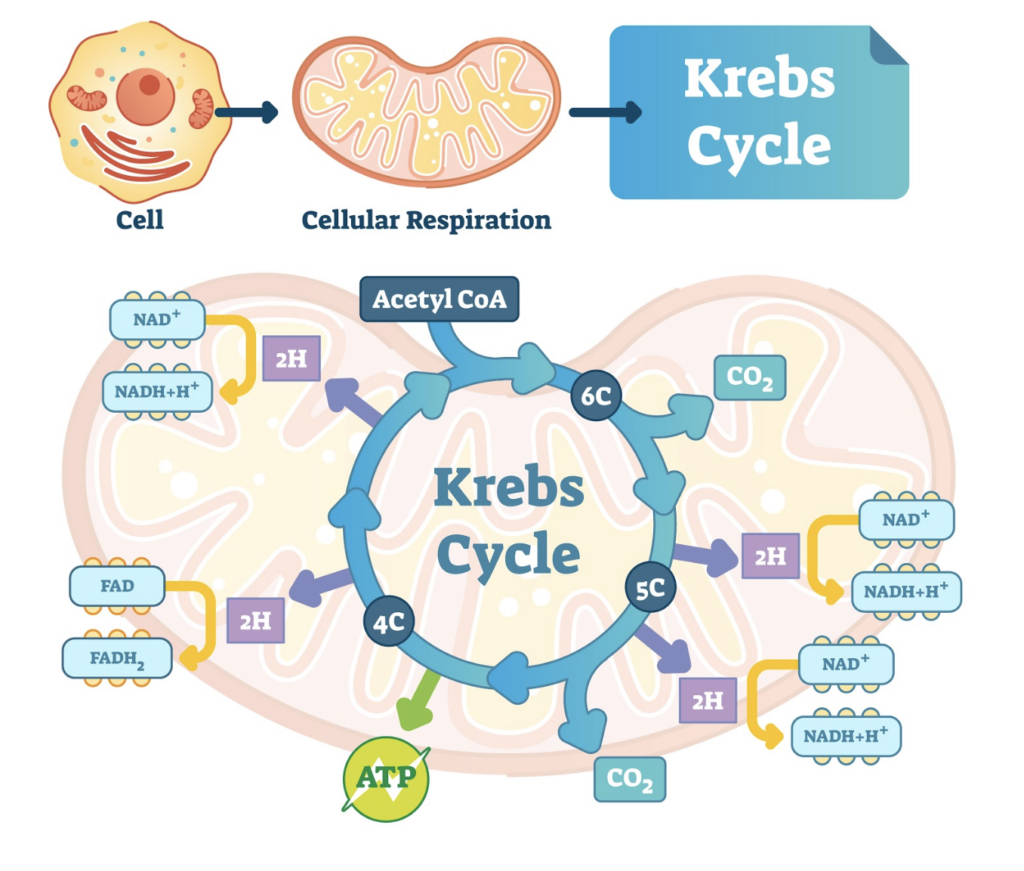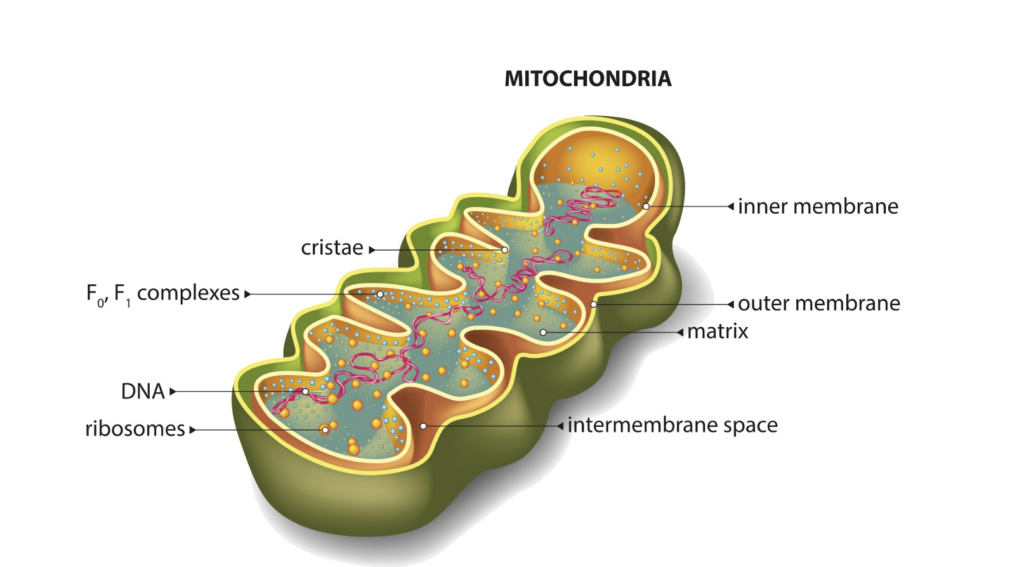The body is an incredible bundle of complex functions that work together for the purpose of keeping you vibrant and alive. The more we understand these functions and how to keep them running smoothly, the better our chances to increase longevity and overall quality of life.
This brings me to mitochondria, skin, and aging. It’s not likely most people assume that mitochondria function, skin health, and anti-aging go hand in hand, but they’re actually very closely connected.
Research has shown that the health of the mitochondria in your body, a small but mighty piece of our cells, may determine whether or not your skin is in good shape.
What is the mitochondria function and structure?
Mitochondria are the “powerhouses” of the cell. They are called this because of the way that they turn energy from the food we consume into energy that our body can use.
Providing Energy
One major role of mitochondria is to generate most of the adenosine triphosphate (ATP) in our body, a very complex organic chemical found in all forms of life. ATP synthase generates molecules of ATP, resulting in energy production. Through this process, sugar, fat, or protein molecules can be converted into energy.
We are going to get super nerdy here and dive deep into the science on how this all works so grab your favorite coffee, green juice, matcha, or tea and put those nerdy glasses on and get ready cuz here we go…..
First, glucose is broken down through glycolysis, taking place in the cytoplasm of the cell. Glycolysis then produces pyruvate, a molecule later converted to acetyl-CoA. The result of the Krebs cycle is NADH, a chemical that produces ATP.
ATP production occurs in the mitochondria via the citric acid cycle, or the Krebs cycle. Finally, when the ATP from the mitochondria converts food into usable energy, the process is called oxidative phosphorylation, or cellular respiration.
Structure
Mitochondria are found in the cells of all plants and animals and living things with complex cell structures, including the eukaryotic cell. Depending on the cell type, some cells contain only one mitochondrion, while others (muscle cells) may contain thousands.
Mitochondria have two membranes, an inner and an outer membrane. Each part of mitochondria has a different function.
- The outer mitochondrial membrane allows small molecules to pass through; it contains enzymes and mitochondrial proteins.
- The inner membrane holds proteins and houses ATP synthesis.
- The folds within the inner membrane, the cristae, increase surface area available for chemical reactions.
- The space between the outer and inner membranes is the intermembrane space.
- In the mitochondrial matrix, also in the inner membrane, hundreds of enzymes can be found.
These enzymes are important to the production of ATP. DNA is also housed in the matrix. DNA is mostly found in the cell’s nucleus, but mitochondria have their own personal set of DNA, giving the organelle yet another important role.
Like nuclear DNA, mitochondrial DNA (mtDNA) holds information for many proteins and genes.
As you age, mitochondrial function may start to decline. Research has linked mitochondrial dysfunction to Alzheimer’s disease, Parkinson’s disease, and cancer.
Mitochondria also play a part in cell death, or apoptosis. Apoptosis happens when cells become old and no longer function the way they are supposed to and then exit the body or are destroyed.
How Mitochondria Function Can Help Aging Skin
Mitochondrial disease and dysfunction have been linked to aging. Reactive oxygen species (ROS) are produced in mitochondria during the energy production process. ROS are highly charged particles that can damage DNA, fats, and proteins.
Research states, “The hydroxyl radical is considered to be the most damaging form of ROS, as it is highly reactive and causes oxidative damage to virtually every molecule type in the cell, including lipids, proteins, and nucleic acids.”
When mitochondrial DNA is damaged, duplication of the damage occurs when cells reproduce. Over time, more damaged cells accumulate, resulting in the appearance of aging.
While there’s no way to stop this process entirely, slowing the aging process may be possible by reducing the damage to this mitochondrial DNA.
There is even more evidence that supports the idea that mitochondrial dysfunction and oxidative stress contribute to the development of skin photoaging. Photoaging is the premature aging of the skin. This is caused by repeated exposure to ultraviolet radiation (UV). UV light comes primarily from the sun, but can also come from artificial UV sources (like a tanning bed).
When ROS production is high, mtDNA are exposed to oxidative damage, and the mutational rate is much higher. When mtDNA mutations increase, normal mitochondrial function decreases and signs of skin aging, such as fine lines, wrinkles, and discoloration may occur.
In genetics, “deletion” means a DNA mutation where a sequence is missing. This could lead to disease or error occurring during skin cell replication.
In one study, the epidermal keratinocytes, or cells on the outermost layer of the skin, were more sensitive to mitochondrial dysfunction and exposure to UV radiation. According to this study, two weeks of sun exposure (particularly UVA radiation) can lead to a 40% increase in the levels of common deletion in the dermis. This can persist for up to 16 months.
When mitochondria are functioning properly, the aging process is normal and slow.
How To Protect and Encourage Mitochondria Function
Would you like to delay the appearance of fine lines, crow’s feet around your eyes, or reduce dark spots due to sun damage? Healthy mitochondria function could potentially help aging skin. Therefore, caring for the mitochondria in your body is a form of skin care.
Improving the health of mitochondria may improve the health in our organs, skin, and entire body. There are several things that we can do to keep our mitochondria in good health.
Studies show that eating a healthy, balanced diet with little to no sugar and fewer-than-average carbohydrates can improve mitochondrial function. Consuming a large number of carbs may increase the production of free radicals and other toxins in the body.
Free radicals are particles which damage healthy cells. An overabundance of these particles can even affect the skin’s structural layer and, in some cases, its collagen production. Excessive free radicals result in damage to skin cells, wrinkles, and unevenness in skin tone.
Eating too much or following an unhealthy diet can lead to oxidative stress, the term for the damage caused by free radicals. There have been some instances where a ketogenic diet has been proven to promote the creation of mitochondria and offset a lot of oxidative stress.
Taking certain supplements such as niacinamide to promote healthy mitochondria can aid in keeping skin young. Another beneficial supplement for this may be polyphenol extracts. Polyphenols are naturally occurring antioxidant chemicals found in plants such as fruits, vegetables, and legumes.
A 2016 double-blind trial found that polyphenol supplements may have caused an increase in the function of mitochondria in muscles.
Exercising regularly and avoiding environmental toxins are other ways to ensure that mitochondria function properly, making them great additions to your anti-aging regimen.
It’s always a good idea to apply sunscreen and use that SPF to your advantage by limiting exposure to UV rays — and potential damage to your mitochondria. Be sure to discuss any new skincare routine or products with a dermatologist, especially when dealing with sensitive skin types.
In Summary
- Mitochondria are often referred to as the powerhouses of the cell due to their ability to turn energy from food into usable energy for our bodies.
- Generating ATP for energy is a major role for mitochondria. This happens during a process called cellular respiration.
- Mitochondria have complex structures, complete with two membranes. They hold DNA with information important to several proteins and genes.
- Mitochondrial dysfunction has been linked to diseases such as Alzheimer’s, Parkinson’s, and cancer. When mitochondria don’t function properly, the aging process speeds up.
- According to research, mitochondria dysfunction can contribute to photoaging, especially when the skin is exposed to UV radiation.
- In order to avoid mitochondrial dysfunction, we need to eat a balanced diet and introduce the right supplements to achieve long lasting healthy skin.
Sources
- Siekevitz, P. (1957). Powerhouse of the cell. Scientific American, 197(1), 131-144. Abstract: https://www.jstor.org/stable/24940890?seq=1#page_scan_tab_contents
- Cooper, T. G., & Beevers, H. (1969). Mitochondria and glyoxysomes from castor bean endosperm Enzyme constituents and catalytic capacity. Journal of Biological Chemistry, 244(13), 3507-3513. Full Text: https://www.ncbi.nlm.nih.gov/books/NBK9896/
- Berg, J. M., Tymoczko, J. L., & Stryer, L. (2002). The respiratory chain consists of four complexes: three proton pumps and a physical link to the citric acid cycle. Biochemistry, 5, 320-323. Full Text: https://www.ncbi.nlm.nih.gov/books/NBK21163/
- Jonckheere, A. I., Smeitink, J. A., & Rodenburg, R. J. (2012). Mitochondrial ATP synthase: architecture, function and pathology. Journal of inherited metabolic disease, 35(2), 211-225. Full Text: https://www.ncbi.nlm.nih.gov/pmc/articles/PMC3278611/
- Chan, D. C. (2006). Mitochondria: dynamic organelles in disease, aging, and development. Cell, 125(7), 1241-1252. Full Text: https://www.sciencedirect.com/science/article/pii/S0092867406007689
- Weinberg, S. E., & Chandel, N. S. (2015). Targeting mitochondria metabolism for cancer therapy. Nature chemical biology, 11(1), 9. Full Text: https://www.ncbi.nlm.nih.gov/pmc/articles/PMC4340667/
- Elmore, S. (2007). Apoptosis: a review of programmed cell death. Toxicologic pathology, 35(4), 495-516. Full Text: https://www.ncbi.nlm.nih.gov/pmc/articles/PMC2117903/
- Bratic, A., & Larsson, N. G. (2013). The role of mitochondria in aging. The Journal of clinical investigation, 123(3), 951-957. Full Text: https://www.jci.org/articles/view/64125
- Naidoo, K., Hanna, R., & Birch‐Machin, M. A. (2018). What is the role of mitochondrial dysfunction in skin photoaging?. Experimental dermatology, 27(2), 124-128. Abstract: https://www.researchgate.net/publication/321476300_What_is_the_role_of_mitochondrial_dysfunction_in_skin_photoaging
- Koch, H., Wittern, K. P., & Bergemann, J. (2001). In human keratinocytes the Common Deletion reflects donor variabilities rather than chronologic aging and can be induced by ultraviolet A irradiation. Journal of investigative dermatology, 117(4), 892-897. Full Text: https://www.jidonline.org/article/S0022-202X(15)41393-4/fulltext
- Cioffi, F., Senese, R., Lasala, P., Ziello, A., Mazzoli, A., Crescenzo, R., … & Iossa, S. (2017). Fructose-rich diet affects mitochondrial DNA damage and repair in rats. Nutrients, 9(4), 323. Full Text: https://www.mdpi.com/2072-6643/9/4/323/htm
- Poljšak, B., & Dahmane, R. (2012). Free radicals and extrinsic skin aging. Dermatology research and practice, 2012. Full Text: https://www.ncbi.nlm.nih.gov/pmc/articles/PMC3299230/
- Rinnerthaler, M., Bischof, J., Streubel, M., Trost, A., & Richter, K. (2015). Oxidative stress in aging human skin. Biomolecules, 5(2), 545-589. Full Text: https://www.ncbi.nlm.nih.gov/pmc/articles/PMC4496685/
- Gano, L. B., Patel, M., & Rho, J. M. (2014). Ketogenic diets, mitochondria, and neurological diseases. Journal of lipid research, 55(11), 2211-2228. Abstract: https://www.ncbi.nlm.nih.gov/pubmed/24847102
- Menaa, F., Menaa, A., & Tréton, J. (2014). Polyphenols against skin aging. In Polyphenols in Human Health and Disease (pp. 819-830). Academic Press. Abstract: https://www.sciencedirect.com/science/article/pii/B9780123984562000633
- Most, J., Timmers, S., Warnke, I., Jocken, J. W., van Boekschoten, M., de Groot, P., … & Blaak, E. E. (2016). Combined epigallocatechin-3-gallate and resveratrol supplementation for 12 wk increases mitochondrial capacity and fat oxidation, but not insulin sensitivity, in obese humans: a randomized controlled trial. The American journal of clinical nutrition, 104(1), 215-227. Full Text: https://academic.oup.com/ajcn/article/104/1/215/4569664
- Agadjanyan, M., Vasilevko, V., Ghochikyan, A., Berns, P., Kesslak, P., Settineri, R. A., & Nicolson, G. L. (2003). Nutritional supplement (NT Factor™) restores mitochondrial function and reduces moderately severe fatigue in aged subjects. Journal of Chronic Fatigue Syndrome, 11(3), 23-36. Full Text: https://www.researchgate.net/publication/235919001_Nutritional_Supplement_NT_Factor_Restores_Mitochondrial_Function_and_Reduces_Moderately_Severe_Fatigue_in_Aged_Subjects
- Meyer, J. N., Leung, M. C., Rooney, J. P., Sendoel, A., Hengartner, M. O., Kisby, G. E., & Bess, A. S. (2013). Mitochondria as a target of environmental toxicants. Toxicological sciences, 134(1), 1-17. Full Text: https://academic.oup.com/toxsci/article/134/1/1/1666668




